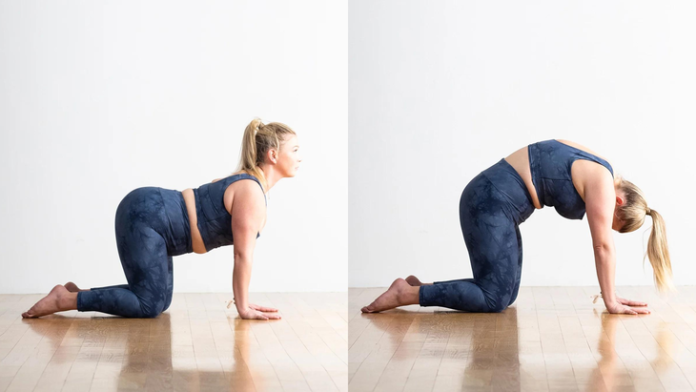“], “filter”: { “nextExceptions”: “img, blockquote, div”, “nextContainsExceptions”: “img, blockquote, a.btn, a.o-button”} }”>
Heading out the door? Read this article on the new Outside+ app available now on iOS devices for members!
>”,”name”:”in-content-cta”,”type”:”link”}}”>Download the app.
Chances are at some point you’ve asked yourself whether you should do a little stretching after you’ve exhausted yourself lifting weights or doing any sort of resistance training. And you probably quickly dismissed the notion. After all, you can barely create space in your schedule for your actual workouts. But what may not have occurred to you is that taking just a couple minutes to practice some strength-straining stretches will exponentially amplify the work you just did at the gym.
Research suggests that stretches, including certain yoga poses, may reduce delayed-onset muscle soreness (DOMS), expediting recovery and making your next workout less excruciating. Put simply, if you strength train, you need to stretch.
As an athletic trainer, I coach clients who strength train to include several yoga poses in their cool-down routine. Your effort doesn’t need to be particularly long or involved. When you strategically select stretches that target the muscles you worked in your resistance training workout, you’ll see and feel impressive benefits with just a handful of poses.
Essential Strength-Training Stretches
The following sequence of strength-training stretches address all the major muscle groups. Practice it in its entirety or, on those days when you have even less time than usual, select specific stretches as needed that target your back, legs, or upper body.
I suggest holding each pose for 30 to 45 seconds, depending on how tight you feel after lifting weights. The entire post-weightlifting stretching routine takes less than 10 minutes.
1. Cat-Cow
Not all yoga poses require you to get into a specific posture and then hold it statically. Cat-Cow is a dynamic yoga exercise that improves mobility throughout the spine. It’s beneficial not only for mobility of the back but also the hips. This is one of the best yoga exercises after weight lifting, but it can also be performed as part of a dynamic warm-up.
Also, Cat-Cow requires you to move between an anterior and posterior pelvic tilt. Being able to consciously perform a posterior pelvic tilt is critical for any supine weightlifting exercise, such as the bench press. You need to be able to know what it feels like to engage the lower abdominal muscles and press your low back and back of the pelvis into the bench to prevent straining your back.
How to: Be certain to connect your movement with your breath and don’t rush it. Slowly inhale as you press your hands into the mat, arch your back, and draw your chest forward in Cow. Slowly exhale as you draw your abs toward your spine, round your back, and relax your neck in Cat. Improving this mind-body connection can help you better activate your core muscles when you are performing other strength training exercises with weights.
2. Puppy Pose
One of the best strength training stretches for the upper body, Puppy Pose releases tightness after you’ve worked your shoulders, arms, and upper back.
How to: After you’ve found the basic shape of Puppy Pose, think about lifting your hips and stacking them directly over your knees. Try to lengthen through your spine and side body. Feel the stretch along your armpits. You can either rest your arms on the floor or actively engage them. I like to envision myself pressing my armpits into the mat.
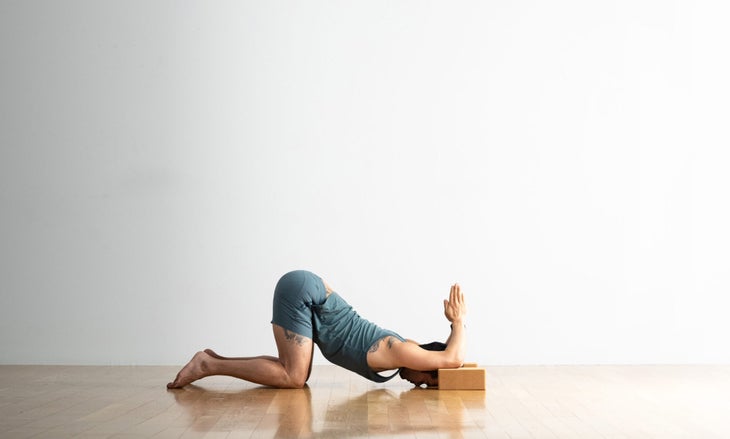
To intensify the stretch, rest your elbows on blocks and stay here or bring your palms to touch and take your thumbs toward the back of your head.
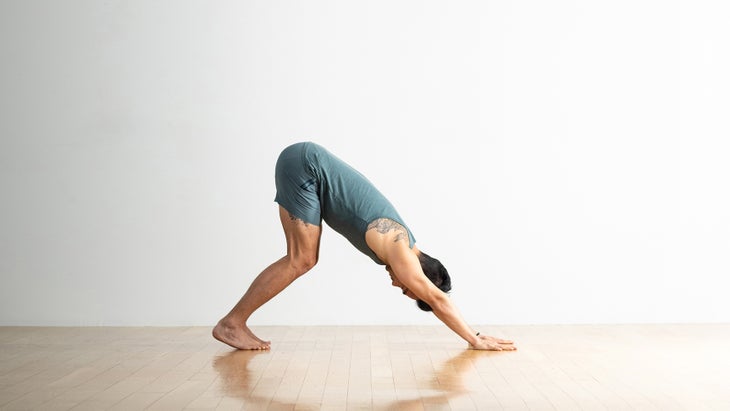
Downward-Facing Dog
One of the most well-known yoga poses, Downward-Facing Dog is one of the best stretches for anyone who lifts weights or practices resistance training in any way. The pose stretches the entire posterior chain, including your calves, hamstrings, spine, and upper back. If you have time for just a single stretch after strength training, I highly suggest doing this yoga pose, no matter what exercises you did, because there’s a good chance that Downward Dog will help stretch out at least one of the muscles worked in your weightlifting session.
This yoga pose is especially beneficial for anyone who performs squats because it stretches the calf muscles and Achilles tendons. Tightness in these tissues will limit your squat depth and make it difficult to keep your heels firmly grounded when lowering your body into a back squat. Without this stability and mobility, you risk losing your balance and you also reduce the permissible range of motion. Without that full range of motion, your muscles will lack the maximum stimulus required for maximum strength gains.
How to: The key to Downward-Facing Dog is lifting your hips up toward the ceiling and reaching your heels down toward the mat. Plant your palms firmly on the ground with your fingers spread nice and wide. You should have a straight line from your wrists through your arms, shoulders, and hips. Then, you should mirror this straight line and a similar angle from the hips down through your heels. Draw your abdominal muscles in by connecting with your core.
If you cannot reach your heels to the mat due to tightness in your hamstrings or lower back, either bend your knees or bring your hands onto yoga blocks or a low plyometric box at the gym. This helps you touch your heels to the ground and lengthen the muscles of the lower legs.
Then slowly bend your knees and relax down onto all fours. If time allows, press back up into another Downward Dog.
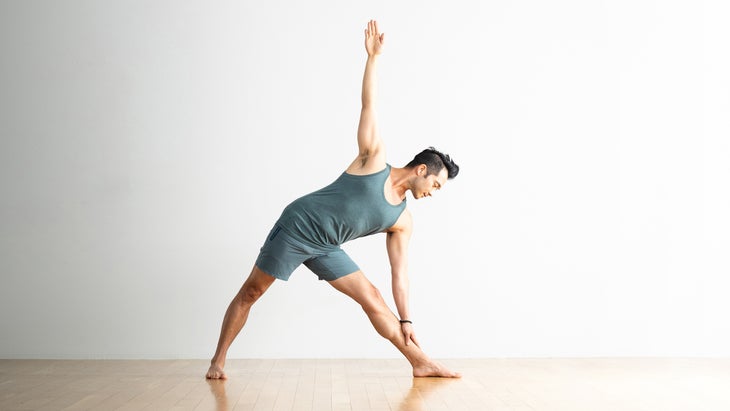
Extended Triangle Pose
Any version of Triangle Pose will help stretch your hips, spine, glutes, hamstrings, and inner and outer thighs. Best of all, this is an excellent stretch after chest workouts because it creates space across the pectoral region and shoulder girdle. Rely on this stretch after bench pressing or performing chest fly.
How to: Spread your weight evenly between both feet and ground them into the mat. If you cannot reach the ground with the front hand, rest it on your shin or a yoga block. Don’t forget to switch sides.
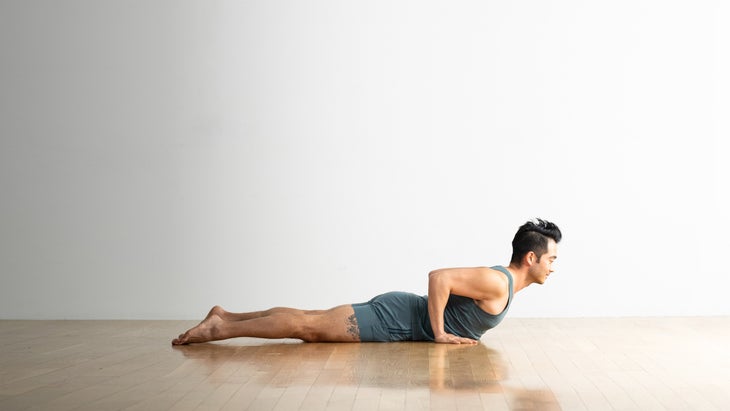
Cobra Pose
Similar to Triangle, Cobra initiates a stretch across the chest, shoulders, and abdominal muscles. It also forces you to backbend but in a supported fashion, using your hands to initiate the movement.
How to: Squeeze your glutes and press the front of your pelvis into the mat to support proper muscle engagement as you lift your chest. If you want to make this not only a stretch but a strengthening pose for your lower back, lift your palms off the mat so you initiate and hold the shape of the stretch using the muscles of the lower back.
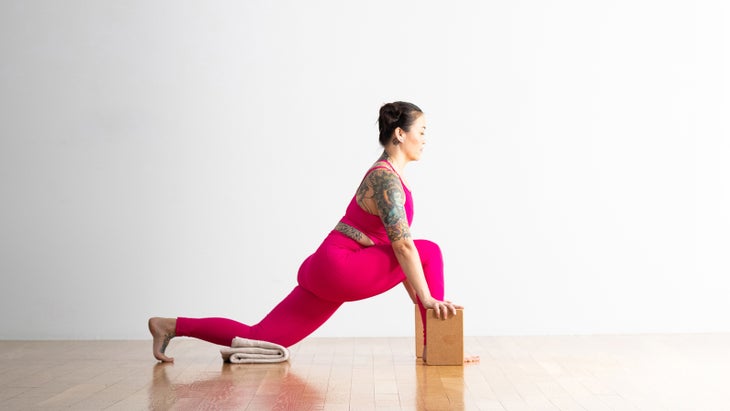
Low Lunge
This is one of the best yoga poses to stretch quads and hip flexors, which are the muscles along the front of your thigh. The quads are key knee stabilizers for squatting, while the hip flexors help stabilize the pelvis when you lift the bar while deadlifting. The hip flexors are also worked during any sort of lunges, hip thrusts, or kettlebell swings, so it’s important to stretch them after a leg workout.
How to: Come into a lunge and drop your back knee and bring your hands to the mat or blocks beneath your shoulders. Inch your back knee a little further away from you until you feel a stretch along the front of your thigh. Press down through your palms and lift your chest to avoid collapsing in your low back. Switch sides.
You can repeat any of the strength training stretches where you feel like you need to target the muscles again.


